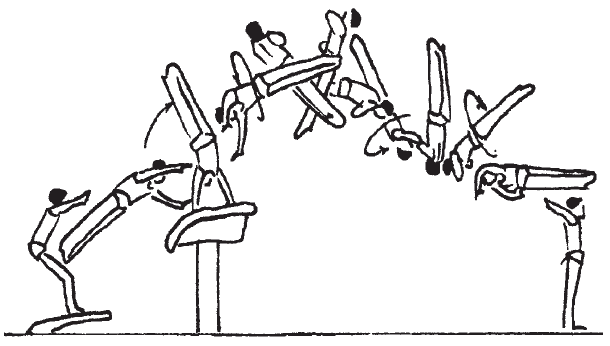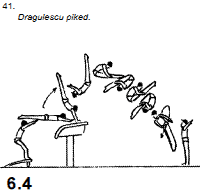The gymnastics vault has seen an evolution in terms of complexity and risk in recent years – discover the 6 Hardest Vaults in Men’s Gymnastics. This collection showcases gymnasts from around the world pushing the boundaries of what is humanly possible.
In this article, we’ll dive into the six hardest vaults in men’s gymnastics that leave audiences in awe.
Men’s Vault
Male gymnasts compete for vault by choosing a specific skill to perform over the apparatus. In major competitions, they get two attempts so they actually compete two separate vaults.
Judges score the gymnasts by adding two scores together:
- Difficulty value.
- Execution out of 10.
To help select the hardest vaults in men’s gymnastics we focused on the vaults with the highest difficulty value because the hardest vaults are worth more.
Difficulty values are calculated by taking into account how many somersaults and how many twists are performed in the move.
Before we get into the detail, you should know that all vaults fall into one of three categories of type of vaults:
- Handspring – forwards and passes through handstand
- Tsukahara – A round off on the vault table followed by a somersault
- Yurchenko – A round off onto the springboard into a back handspring on the vault
The Shirai II Vault
Named after the Japanese gymnast Kenzo Shirai, the Shirai II is a testament to this athlete’s unmatched prowess on the vault. This challenging vault consists of a Yurchenko entry followed by a triple and half twist in the layout position. The quick rotations and the precision required to stick the landing make this one of the most challenging vaults to execute perfectly.
Kenzo Shirai also has two other vaults named after him; The Shirai and the Shirai III however, the Shirai II has been rated the most difficult of the three in the FIG Code of Points.
| Category | Yurchenko |
| First Seen | 2016 Rio Olympic Games |
| Description | Round off on the springboard, back handspring on the vault into a layout with three and a half twists |
The Ri Se Gwang
Originating from North Korea’s Ri Se Gwang, this vault is as impressive as the gymnast it’s named after. Combining a handspring front takeoff with a double somersault and half twist in the tucked position. It demands an impeccable sense of timing, immense strength, and spatial awareness from the gymnast.
Ri is the only gymnast with two of the hardest vaults in the code of points being accredited to him.
| Category | Tsukahara |
| First Seen | 2009 World Championships |
| Description | A full twisting double somersault in the tucked position |

The Ri Se Gwang II
Pushing the limits even further, the Ri Se Gwang II incorporates a handspring double front somersault with a full twist. The additional twist intensifies the complexity and raises the stakes in terms of landing. It’s no wonder that this vault is reserved for elite gymnasts who possess the skill and courage to attempt it.
| Category | Forward Handspring |
| First Seen | 2008 Asian Games (Doha) |
| Description | Front Handspring double somersault piked with half twist out |
The Yang Hak Seon
Named after the South Korean gymnast Yang Hak Seon, this vault is a true spectacle. It features a handspring into a triple twist before landing, demanding impeccable execution and control. Yang’s mastery of this vault led him to Olympic gold in 2012, solidifying its place among the toughest vaults in the sport.
| Category | Forward Handspring |
| First Seen | 2011 World Championships |
| Description | Handspring into a single somersault in the layout position with 3 and half twists |

Tsukahara 3 and Half Twists
The Tsukahara vault has been around for decades, but when you add 3 and a half twists to it, the difficulty level shoots up dramatically. The gymnast performs a half turn onto the table followed by a backflip with three and a half twists. The sheer number of rotations in such a short span requires gymnasts to have exceptional air awareness and rotational speed.
| Category | Tsukahara |
| First Seen | 2013 |
| Description | Tsukaraha into a layout somersault with three and a half twists |

Dragulescu Piked
The Dragulescu Piked is named after the Romanian gymnast Marian Dragulescu, known for his prowess on the vault. This difficult vault consists of a handspring double front somersault in the piked position. The piked position, as opposed to the tucked, demands an even higher level of precision and control due to the extended leg position, making it one of the most challenging vaults in gymnastics.
| Category | Forward Handspring |
| First Seen | 2004 Athens Olympic Games |
| Description | Handspring into double piked somersault |

Final Thoughts
In conclusion, the evolution of vaulting in men’s gymnastics has seen some of the most incredible and awe-inspiring feats of athleticism. These six hardest vaults in men’s gymnastics, each with its unique blend of rotations, twists, and somersaults, stand testament to the ever-advancing boundaries of the sport.
As gymnasts continue to innovate and push their limits, we can only anticipate more groundbreaking vaults in the years to come.
Sources
Federation International Gymnastics MAG Code of Points
FAQs
Do men compete in vault?
Yes, both men and women compete in vault. They also both compete on floor whereas all other apparatus are only competed by either men or women.
How do vault moves get their names?
Gymnastics vaults get their names from the first gymnast to successfully compete the skill at a major event. This tradition stretches back to the 1950s and 60s when vaults such as the Tsukahara, Yurchenko and Yamashita were first seen.
The Federation of International Gymnastics (FIG) decide whether to accept new skills into their code of points and make the name official.
Is men’s gymnastics harder than women’s?
At an elite level, male gymnasts are generally able to compete harder skills than women. This is especially true on vault where greater power and speed allow gymnasts to perform multiple somersaults and twists before landing.
Young gymnasts both male and female have to work extremely hard to improve their vaults.
Why can’t men do uneven bars?
Uneven Bars are competed only by women whereas men compete on the single high bar. The rules for the sport are agreed and implemented by the Federation of International Gymnastics.
Men tend to be taller than women and would hit their feet on the lower Uneven bar. By competing on a single high bar they don’t have to worry about hitting the other bar and are able to perform bigger swings and somersaults.
- How To Get Over a Mental Block In Gymnastics: A Complete Guide
 Gymnastics is a sport that requires not only physical strength and skill but also mental strength. When a gymnast feels like they cannot attempt a… Read more: How To Get Over a Mental Block In Gymnastics: A Complete Guide
Gymnastics is a sport that requires not only physical strength and skill but also mental strength. When a gymnast feels like they cannot attempt a… Read more: How To Get Over a Mental Block In Gymnastics: A Complete Guide - Find The Best Leotard For Girls (Guide)
 Finding an ideal leotard for girls isn’t just about picking a dazzling design that sparkles (although it does help!). The leotard has to fit perfectly,… Read more: Find The Best Leotard For Girls (Guide)
Finding an ideal leotard for girls isn’t just about picking a dazzling design that sparkles (although it does help!). The leotard has to fit perfectly,… Read more: Find The Best Leotard For Girls (Guide) - The Best Gymnastics Shorts (Our Top Picks)
 The best gymnastics shorts are designed to be worn over the top of a leotard providing additional coverage around the upper legs, whilst allowing gymnasts… Read more: The Best Gymnastics Shorts (Our Top Picks)
The best gymnastics shorts are designed to be worn over the top of a leotard providing additional coverage around the upper legs, whilst allowing gymnasts… Read more: The Best Gymnastics Shorts (Our Top Picks) - Decathlon Leotards – Are They Any Good?
 If you’re in the market for a new leotard, you may be wondering if Decathlon leotards are any good considering the low cost of their… Read more: Decathlon Leotards – Are They Any Good?
If you’re in the market for a new leotard, you may be wondering if Decathlon leotards are any good considering the low cost of their… Read more: Decathlon Leotards – Are They Any Good? - A Complete Guide to Gymnastics Hand Rips
 Are you tired of dealing with painful gymnastics rips on your hands from training? Look no further – this article offers a comprehensive approach to… Read more: A Complete Guide to Gymnastics Hand Rips
Are you tired of dealing with painful gymnastics rips on your hands from training? Look no further – this article offers a comprehensive approach to… Read more: A Complete Guide to Gymnastics Hand Rips - Is Gymnastics Dangerous? (Facts and Comparisons)
 Gymnastics is acknowledged as a highly technical and physically demanding sport. It inherently carries a risk of injury, which is why most coaches and clubs… Read more: Is Gymnastics Dangerous? (Facts and Comparisons)
Gymnastics is acknowledged as a highly technical and physically demanding sport. It inherently carries a risk of injury, which is why most coaches and clubs… Read more: Is Gymnastics Dangerous? (Facts and Comparisons)
